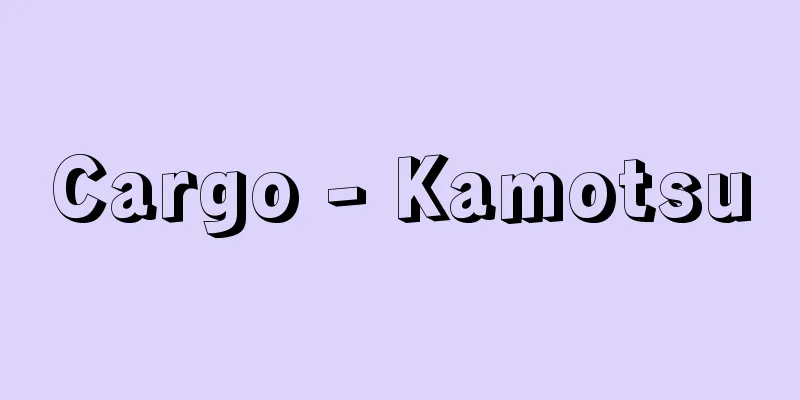Cargo - Kamotsu

|
A general term for goods transported by a means of transportation. When classified based on the way cargo is handled, it can be divided into general cargo and special cargo. Special cargo is cargo that requires special handling and stowage, and includes liquids, powdered liquids, animals, plants, heavy goods, and dangerous goods. In contrast, general cargo, also known as miscellaneous goods, is a general term for cargo that does not require special handling. Industrial products, food, agricultural products, etc. packed in cardboard boxes that we normally see are classified as general cargo. The unit of measurement for the size of cargo on a macro level is the weight in tons multiplied by the distance traveled (in kilometers), called ton-kilometers. The volume of cargo transported in Japan increased significantly during the period of high economic growth from the late 1950s, but growth slowed in the 1970s. The volume of cargo transported in fiscal 1999 (Heisei 11) was 558.1 billion ton-kilometers, four times the volume in fiscal 1960 (Showa 35). The modes of freight transport are automobiles (trucks), railways, domestic shipping, and air transport, and the proportion of freight transported by each mode is indicated as the mode share. Looking at the mode share in Japan, the trend towards freight transport becoming increasingly dependent on trucks is evident. In fiscal 2000, the mode share of trucks in terms of tonnage was 90.6%, compared with 8.4% for domestic shipping, 0.9% for railways, and 0.0% for air transport. Trucks still make up an overwhelming proportion of freight transport, and in contrast, the role of railways, which used to be the main mode of transport, has significantly decreased. In terms of ton-kilometers, taking into account the distance traveled, trucks accounted for 54.2%, domestic shipping for 41.8%, railways for 3.8%, and air transport for 0.2%, meaning that trucks, which were not originally very competitive in long-distance transport, are now the largest mode of transport even on a ton-kilometer basis. In modern freight transport, there is a strong demand for reducing transport costs, shortening transport times, and making transport more convenient. Trucks are better suited to these conditions than other means of transport, and as a result, they transport the majority of freight generated by economic activity. Recently, there have been major changes in cargo. First of all, the cargo being transported is becoming lighter, thinner, shorter, and smaller; this phenomenon is called "lightweight, thin, short, and compact." As exemplified by computers, technological innovation is leading to products becoming smaller and smaller. As the cargo itself is becoming smaller, it is fitting into the category of home delivery services, which are small cargo transport services with a maximum weight of 20 to 30 kilograms. The trend toward lighter, thinner, shorter, and smaller cargo is thought to be one of the factors behind the rapid expansion of the home delivery market. Furthermore, the way cargo is transported has changed significantly in recent years. This is called frequent small parcels. For example, cargo delivered to factories and stores used to be transported in bulk once a week, but now it is delivered daily at the request of the customer. In simple terms, this means that the number of transports will increase seven-fold, while the amount of cargo per transport will decrease to one-seventh of the previous amount. This frequent small parcels approach is being taken to eliminate waste, so that the companies receiving the goods do not have to hold the cargo as inventory. Just-in-time transport, which delivers "what is needed, when it is needed, and in the amount needed," is a typical example of frequent small parcels. Frequent, small parcel shipments are now common. This type of freight transport prioritizes the convenience of the ordering party, and conversely, it makes the logistics system of the delivering company more complicated and increases costs. In addition, the spread of frequent, small parcel shipments has led to an increase in the number of inefficient transports on a macro level, raising concerns about the impact on road traffic, including environmental problems and worsening traffic congestion. General cargo also comes in a variety of shapes and characteristics, and the major challenge was how to handle such cargo efficiently. Containers and pallets are methods to achieve this goal. A container is a standardized container for transport that can be loaded with cargo and can be transported on various different means of transport, while maintaining a certain level of strength and protecting the cargo. The container itself can also be used repeatedly. In international maritime transport, import and export cargo is loaded into internationally standardized containers of 20 feet (about 6 meters) or 40 feet. The use of such containers has greatly improved the efficiency of loading and unloading at terminals such as ports and freight stations, improving the efficiency and time of cargo transport. The widespread use of the method of transporting cargo in containers is called containerization. Pallets are also used to make loading cargo onto transport vehicles more efficient. A pallet is a standardized platform for loading and storing cargo. By placing cargo on a pallet and then using a forklift to load or unload the cargo onto or from a transport vehicle, loading and storing the cargo can be greatly improved. In addition, loading cargo onto a pallet and transporting and storing the cargo from departure to arrival without dismantling it is called palletization through transit. [Minoru Saito] "The Transportation Industry" by Hiroshi Nomura (1980, Toyo Keizai Shinposha)" ▽ "Modern Railway Freight Transport" by Hiroo Nakajima (1997, Seizando Shoten)" ▽ "Modern Truck Industry" edited by Cargo News (1998, Seizando Shoten) " ▽ "Transportation" by Toru Sakurai et al. (2001, Otsuki Shoten) [Reference items] | | | | |Source: Shogakukan Encyclopedia Nipponica About Encyclopedia Nipponica Information | Legend |
|
輸送機関によって運ばれる物品の総称。貨物を取り扱う形態から分類すると、一般貨物と特殊貨物に分けることができる。特殊貨物とは特別な荷扱いや積み付けを必要とする貨物であり、液体、粉流体、動物、植物、重量品、危険品などが含まれる。これに対して一般貨物とは、雑貨ともよばれているが、特殊な取扱いを必要としない貨物の総称である。われわれが通常目にする段ボール箱に詰められた工業製品、食料品、農産物などが、一般貨物に分類される。 マクロ的に貨物の規模を測る単位としては、重量であるトン数と、これに輸送距離(キロメートル)を掛け合わせたトンキロがある。わが国の貨物輸送量は1950年代後半からの高度経済成長期に大幅に増大したが、1970年代に入ると成長は鈍化した。1999年度(平成11)の貨物輸送トンキロは5581億トンキロであり、これは1960年度(昭和35)の4倍に達している。 貨物を運ぶ輸送機関は、自動車(トラック)、鉄道、内航海運、航空があり、それぞれの輸送機関が運んだ貨物の割合は輸送機関分担率として示される。わが国における輸送機関分担率をみると、貨物の輸送はトラックに依存する傾向が一段と強まっている。2000年度(平成12)のトン数ベースにおけるトラックの輸送機関分担率は、90.6%であり、これに対して内航海運8.4%、鉄道0.9%、航空0.0%である。貨物輸送ではトラックが圧倒的なウエイトを占めており、これとは対照的にかつての主要な輸送機関であった鉄道は著しく役割を減じている。また輸送距離を加味したトンキロでは、トラック54.2%、内航海運41.8%、鉄道3.8%、航空0.2%であり、本来長距離輸送において競争力をあまりもっていなかったトラックがトンキロベースでもいまや最大の輸送機関となっている。 現代の貨物輸送では輸送コストの削減、輸送時間の短縮、輸送の利便性などが強く求められている。トラックは他の輸送機関に比較してこうした条件に適合しており、その結果として、経済活動によって生じる貨物の大部分の輸送を担っている。 最近、貨物に大きな変化が生じている。まず輸送対象となる貨物が軽く、薄く、短く、小さくなっており、こうした現象は軽薄短小化とよばれている。たとえば、コンピュータなどに端的に示されるように、技術革新の進展によって製品がますます小型化している。貨物自体が小型化しているために、20~30キログラムを上限とする小型貨物輸送サービスである宅配便の範疇(はんちゅう)に貨物が収まるようになっている。貨物における軽薄短小化の傾向は、宅配便市場が急激に拡大する要因の一つと考えられている。 さらに最近では貨物の運ばれる形態が大きく変化している。これは多頻度小口化とよばれる。たとえば、工場や店舗に納められている貨物は従来1週間に1回まとめて輸送されていたが、納入先の要望によって毎日配送されるようになる。単純に計算すると、これによって輸送回数は従来の7倍に増加し、1回当りの貨物の量は従来の7分の1に減少する。こうした多頻度小口化は、納入先の企業が、運ばれてくる貨物を在庫として抱え込まないように、むだを排除するために行われている。「必要なものを、必要なときに、必要なだけ」配送するジャスト・イン・タイム(just in time)輸送はこの多頻度小口化の典型である。 現在では多頻度小口化が一般に普及している。こうした形態での貨物の輸送は、発注する側の都合が最優先されており、逆に納入する側の企業は物流システムがいっそう複雑になったり、コストの増加を招いたりしている。また、多頻度小口化が普及することによって、マクロ的には非効率な輸送の回数が増加し、環境問題や交通渋滞の悪化など道路交通への影響が懸念されている。 一般貨物においてもさまざまな形状や特質があるが、それらの貨物の取扱いをいかに効率的に行うかが大きな課題であった。こうした課題を実現するための方式として、コンテナやパレットがある。 コンテナは一定の規格に統一された輸送用の容器であり、これに貨物を積み込めば異なる各種の輸送機関に積載可能で、一定の強度が保たれて貨物を保護することができる。またコンテナ自体も反復的に使用することが可能である。国際海上輸送では、20フィート(約6メートル)や40フィートの国際的に統一した規格のコンテナに輸出入貨物が積み込まれている。こうしたコンテナの利用により、港や貨物駅といったターミナルでの荷役が大幅に効率化されて、貨物の輸送効率や輸送時間が改善された。貨物をコンテナで運ぶ方式が普及することをコンテナリゼーション(containerization)とよんでいる。 また貨物を輸送機関に積載する荷役作業を効率化するためにパレットが使われている。パレットは荷役や格納のための規格化された荷台のことであり、パレットの上に貨物を載せ、これをフォークリフトで輸送機関に載せたり、輸送機関から降ろしたりすることで荷役効率を大幅に効率化することができる。また貨物をパレットに積み付けて、発地から着地までその貨物を取り崩すことなく、一貫して輸送・保管することを一貫パレチゼーション(palletization through transit)とよんでいる。 [齋藤 実] 『野村宏著『輸送産業』(1980・東洋経済新報社)』▽『中島啓雄著『現代の鉄道貨物輸送』(1997・成山堂書店)』▽『カーゴニュース編著『現代のトラック産業』(1998・成山堂書店)』▽『桜井徹他著『交通運輸』(2001・大月書店)』 [参照項目] | | | | |出典 小学館 日本大百科全書(ニッポニカ)日本大百科全書(ニッポニカ)について 情報 | 凡例 |
>>: Masami Kamochi - Masami Kamochi
Recommend
Inuyama Castle Town - Inuyama Castle Town
...As a suburb of Nagoya, residential development...
Sapporo Winter Olympic Games - Sapporo Winter Olympic Games
The 11th Winter Olympic Games were held in Sapporo...
Sinentomonyoroi (English spelling)
...The main source of nutrition is mycorrhizae. A...
Cape Awazaki
…It is a small plateau-like island measuring 2km ...
Kengyo - Kengyo
It can also be written as Kenseki. The word means...
al-Zarqali (English spelling)
…The solitary mystic Ibn al-'Arabi wrote the ...
Family tree - Zokufu
A family tree is a record of the lineage of a fam...
Nachtegall, F. (English spelling) NachtegallF
…The gymnastics system developed in Denmark is co...
Rotational projection - Rotational projection
...(4) Local projection drawing When it is suffic...
baryton
…A musical term derived from the Greek word baryt...
Fruit bats - Pteropus genus
...Existing species are distributed in the subtro...
Guillaume de Volpiano (English spelling) Guillaume de Volpiano
…Composer Rameau, sculptor Ludes, and architect E...
Laportea macrostachya (English spelling) Laporteamacrostachya
…[Tetsuichi Yahara]. … *Some of the terminology t...
Gobaishi
Also called fushi. It is the dried galls that deve...
Bastos - Bastos (English spelling)
A city in the southeastern part of Brazil, in the...









